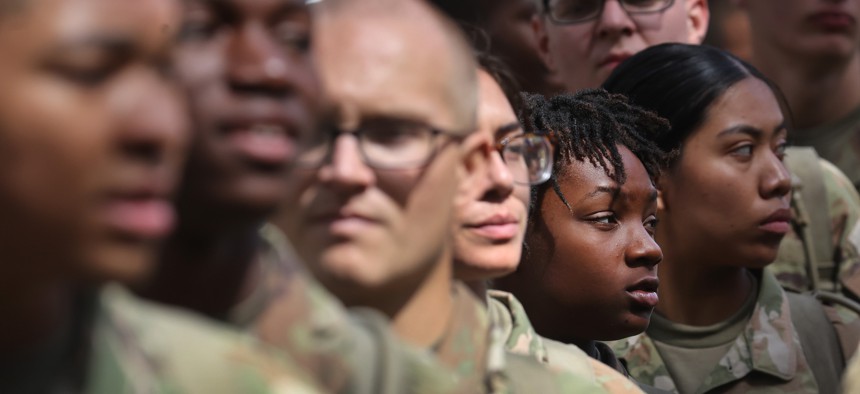
U.S. Army trainees train on the Fit to Win obstacle course during basic training at Fort Jackson. Scott Olson/Getty Images
Is the Army Misplacing the Blame for Its Recruiting Crisis?
At least two of its oft-cited reasons are “red herrings,” experts say.
As experts and Army leaders work to boost the service’s sagging recruitment, they’re discovering that two oft-cited factors aren’t all that important: young people’s ineligibility rates and propensity to serve.
It’s true that only 23 percent of Americans are eligible for military service, and an even smaller portion of that percentage are interested in serving, as Army Chief of Staff Gen. James McConville often says when asked about his service’s recruiting woes. But these factors don’t explain the current crisis, RAND Corporation Senior Economist Beth Asche said at a Heritage Foundation event on Tuesday.
“Propensity is low, but propensity has always been low,” Asche said. “Another one is eligibility. That's a problem, and it's definitely worthy of concern and attention. But again, eligibility has also been a perennial problem for many years.”
These two factors are “red herrings that there's been attention paid to, but I don't think there's a cause of the recent crisis,” she said.
Last year was the “worst year for military recruiting in terms of meeting numerical goals since the start of the all-volunteer force in 1973,” Center for National Defense Director Thomas Spoehr said at the same event. The Army was 15,000 troops short of its fiscal year 2022 recruiting goal and has cut its end-strength goal for 2023 by 15,000, suggesting that service leaders don’t believe they can make up this year’s recruiting deficit.
Asche said the current crisis is driven less by propensity and eligibility rates than by other factors. She also poured cold water on theories that aren’t borne out by visible evidence.
“There are hypotheses going around about how [recruiting challenges are] due to sexual assault stories, food insecurity, the withdrawal from Afghanistan. My colleague, Mr. Spoehr, talked about the ‘woke military.’ There's all sorts of theories going on. We don't have evidence for that,” Asche said.
A recent survey from the Reagan Institute found that half of respondents believe “wokeness” is undermining military effectiveness. But asked in October whether public perceptions of Army wokeness were hurting recruiting, the service’s top recruiter—Maj. Gen. Johnny K. Davis of Army Recruiting Command—said he was “not seeing that at all.”
Both Asche and Davis, who also spoke at the Heritage event, avoided answering a question about whether the COVID-19 vaccine mandate was hurting recruiting.
Asche suggested the Army needs to do a better job of choosing, training, and motivating its recruiters.
Davis pointed to the roughly two years when the COVID pandemic kept students out of school buildings. That was tantamount to “cutting recruiters off from an entire generation,” the general said.
Asche and David agreed that recruiting is also being slowed by Americans’ misconceptions about military service—partly due to media representation and an overall decline in the public’s trust in the military.
Davis said he gets questions from potential recruits all the time that reveal the general population has little understanding of military life. Are you really not paid until you pass basic training? Can you have a family?
“So there are a lot of misconceptions that we have to address,” Davis said. “And we assume that many of our nation's youth understand [the military], but there's an awareness issue.”
Asche suggested the Army take another look at a policy change it announced in July then scrapped after outcry: waiving the requirement of a high school diploma or GED for “a limited number” of recruits. She said such waivers could boost recruiting without reducing the overall quality of the force.
“It does not mean every recruit needs to be a non-graduate, by any means. But when you're already at 95 percent high school grads, going down to 90 percent will not change the quality and performance of that entry cohort,” she said.




